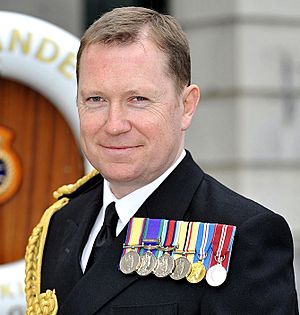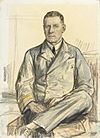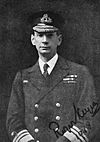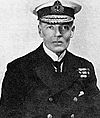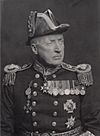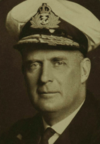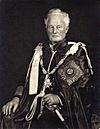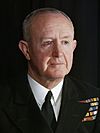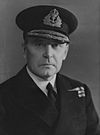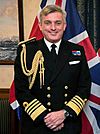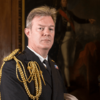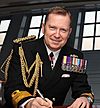Deputy Chief of the Naval Staff (United Kingdom) facts for kids
Quick facts for kids Deputy Chief of the Naval Staff |
|
|---|---|

Ensign of the Royal Navy
|
|
| Ministry of Defence | |
| Abbreviation | DCNS |
| Member of | Board of Admiralty, Admiralty Board, Navy Board |
| Reports to | First Sea Lord |
| Nominator | First Lord of the Admiralty, Secretary of State for Defence |
| Appointer | Prime Minister
Subject to formal approval by the King-in-Council
|
| Term length | Not fixed
(typically 1–3 years)
|
| Formation | 1917–1968, 2013–current |
| First holder | Vice Admiral Henry Oliver |
The Deputy Chief of the Naval Staff (DCNS) is a very important job in the Royal Navy, which is the United Kingdom's navy. This role is currently held by the Second Sea Lord. The person in this position is usually a three-star rank officer, which means they are a very senior leader. Sometimes, this role has been held by officers with slightly different ranks, like a two-star or even a four-star officer.
Contents
The job of Deputy Chief of the Naval Staff was first created in 1917. It was part of the Board of Admiralty, which was like the main leadership group for the Royal Navy. This new role took over some of the responsibilities from an older position called the Chief of the Admiralty War Staff.
During the World Wars
The very first person to be the Deputy Chief of the Naval Staff was Vice Admiral Henry Oliver. He started in this role on May 31, 1917. His duties were shared with the First Sea Lord, who was the top naval officer, and the Assistant Chief of the Naval Staff.
In September 1917, during World War I, a new position called Deputy First Sea Lord was created. For a while, the Deputy Chief of the Naval Staff reported to this new Deputy First Sea Lord. But this changed in 1919 when the Deputy First Sea Lord role was ended. After that, the Deputy Chief of the Naval Staff went back to reporting directly to the First Sea Lord until 1941.
Some of the main jobs of the Deputy Chief of the Naval Staff in 1917 included:
- Helping the First Sea Lord with daily tasks.
- Planning where naval fleets would move.
- Managing naval operations in important areas like the North Sea.
- Protecting trade ships from enemy attacks.
- Dealing with naval matters in foreign areas.
- Organizing and protecting ships that carried troops.
These duties stayed mostly the same until 1939, when World War II began. After 1939, the duties changed to focus more on:
- Big decisions about naval policy and warfare.
- Making sure the fleet was ready for fighting and sailing.
- Deciding where all the ships should be placed.
- Overseeing the naval staff and the Hydrographic Department.
- Managing naval communications.
- Supervising other important naval leaders.
In 1941, the name of the DCNS job was changed to Vice Chief of the Naval Staff. This name was used until 1946. After World War II, the title went back to Deputy Chief of the Naval Staff and continued until 1968.
The Role Returns in 2013
The position of Deputy Chief of the Naval Staff was brought back in 2013. Since then, the person holding this job has been a member of both the Admiralty Board and the Navy Board. These boards are important groups within the Ministry of Defence that help run the Royal Navy.
Around 2014, the duties of the Deputy Chief of the Naval Staff included:
- Leading all the Royal Navy units that can be sent out for missions, including the Royal Marines.
- Making sure that ships, submarines, aircraft, and Royal Marine units are fully ready for any operations the UK government needs.
- Being responsible for providing the right people, equipment, and bases for the Naval Service now and in the future.
Many important naval officers have held this position over the years. Here are some of the people who have served as Deputy Chief of the Naval Staff:
| No. | Deputy Chief | Took office | Left office | Time in office | Ref | |
|---|---|---|---|---|---|---|
| 1 | Vice Admiral Sir Henry Oliver (1865–1965) |
July 1917 | January 1918 | 6 months | . | |
| 2 | Acting Vice Admiral Sir Sydney Fremantle (1867–1958) |
January 1918 | May 1919 | 1 year, 4 months | . | |
| 3 | Vice Admiral Sir Osmond Brock (1869–1947) |
August 1919 | November 1921 | 2 years, 3 months | ||
| 4 | Vice Admiral Sir Roger Keyes (1872–1945) |
November 1921 | May 1925 | 3 years, 6 months | ||
| 5 | Vice Admiral Sir Frederick Field (1871–1945) |
May 1925 | May 1928 | 3 years | ||
| 6 | Admiral Sir Frederic Charles Dreyer (1878–1956) |
June 1930 | January 1933 | 2 years, 7 months | ||
| 7 | Vice Admiral Sir Charles Little (1882–1973) |
January 1933 | October 1935 | 2 years, 9 months | ||
| 8 | Vice Admiral Sir William James (1881–1973) |
October 1935 | October 1938 | 3 years | ||
| 9 | Vice Admiral Sir Andrew Cunningham (1883–1963) |
October 1938 | May 1939 | 7 months | ||
| 10 | Vice Admiral Sir Tom Phillips (1888–1941) |
June 1939 | October 1941 | 2 years, 5 months |
- Note: The post was renamed from 1941 to 1946. Its duties were handled by the Vice Chief of the Naval Staff during that time.
| No. | Deputy Chief | Took office | Left office | Time in office | Ref | |
|---|---|---|---|---|---|---|
| 1 | Rear Admiral Robert Don Oliver (1895–1980) |
April 1946 | April 1947 | 1 year | . | |
| 2 | Vice Admiral Sir Edward Evans-Lombe (1901–1974) |
December 1950 | January 1953 | 2 years, 1 month | . | |
| 3 | Rear Admiral Sir Geoffrey Barnard (1901–1974) |
January 1953 | April 1954 | 1 year, 3 months | ||
| 4 | Vice Admiral Sir Eric Clifford (1900–1964) |
April 1954 | September 1957 | 3 years, 5 months |
- Note: From 1957 to 1965, the job was also held by the Fifth Sea Lord.
| No. | Deputy Chief | Took office | Left office | Time in office | Ref | |
|---|---|---|---|---|---|---|
| 1 | Vice Admiral Sir Manley Power (1904–1981) |
October 1957 | February 1959 | 1 year, 4 months | . | |
| 2 | Admiral Sir Laurence Durlacher (1904–1986) |
February 1959 | January 1962 | 2 years, 11 months | ||
| 3 | Vice Admiral Sir Peter Gretton (1912–1992) |
January 1962 | January 1963 | 1 year | ||
| 4 | Vice Admiral Sir Frank Hopkins (1910–1990) |
January 1963 | March 1966 | 3 years, 2 months | ||
| 5 | Vice Admiral Sir Richard Janvrin (1915–1993) |
March 1966 | October 1968 | 2 years, 7 months |
- Note: The position was empty from 1969 to 2012. It was brought back in 2013. From 2013 to 2015, the Fleet Commander held the role, and from 2016, it has been held by the Second Sea Lord.
| No. | Deputy Chief | Took office | Left office | Time in office | Ref | |
|---|---|---|---|---|---|---|
| 1 | Vice Admiral Sir Philip Jones (born 1960) |
30 November 2012 | 8 April 2016 | 3 years, 130 days | ||
| 2 | Vice Admiral Jonathan Woodcock (born 1962) |
8 April 2016 | 27 March 2018 | 1 year, 353 days | ||
| 3 | Vice Admiral Tony Radakin (born 1965) |
27 March 2018 | 26 April 2019 | 1 year, 30 days | ||
| 4 | Vice Admiral Nick Hine (born 1966) |
26 April 2019 | 12 January 2022 | 2 years, 261 days | ||
| 5 | Vice Admiral Martin Connell (born 1968) |
12 January 2022 | Incumbent | 3 years, 339 days |
See also
- Assistant Chief of the Naval Staff
- Vice Chief of the Naval Staff
- First Sea Lord
- Second Sea Lord
- Third Sea Lord
- Fourth Sea Lord
- Fifth Sea Lord


